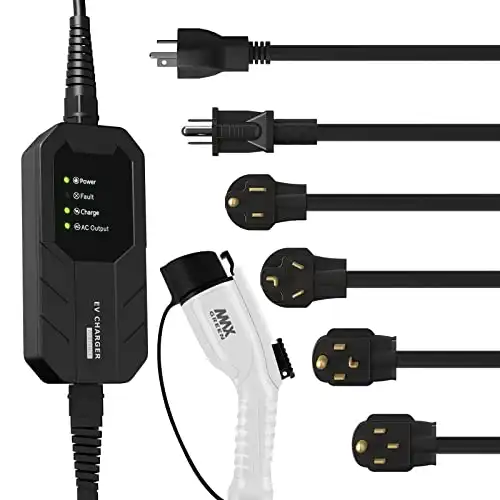With the rise in the number of electric vehicles (EVs) on the road, new questions about where you can and cannot charge them emerge. With camping being such a popular activity and innovative features that make EVs great camping vehicles, the question often arises: Can you charge your electric car at a campground?
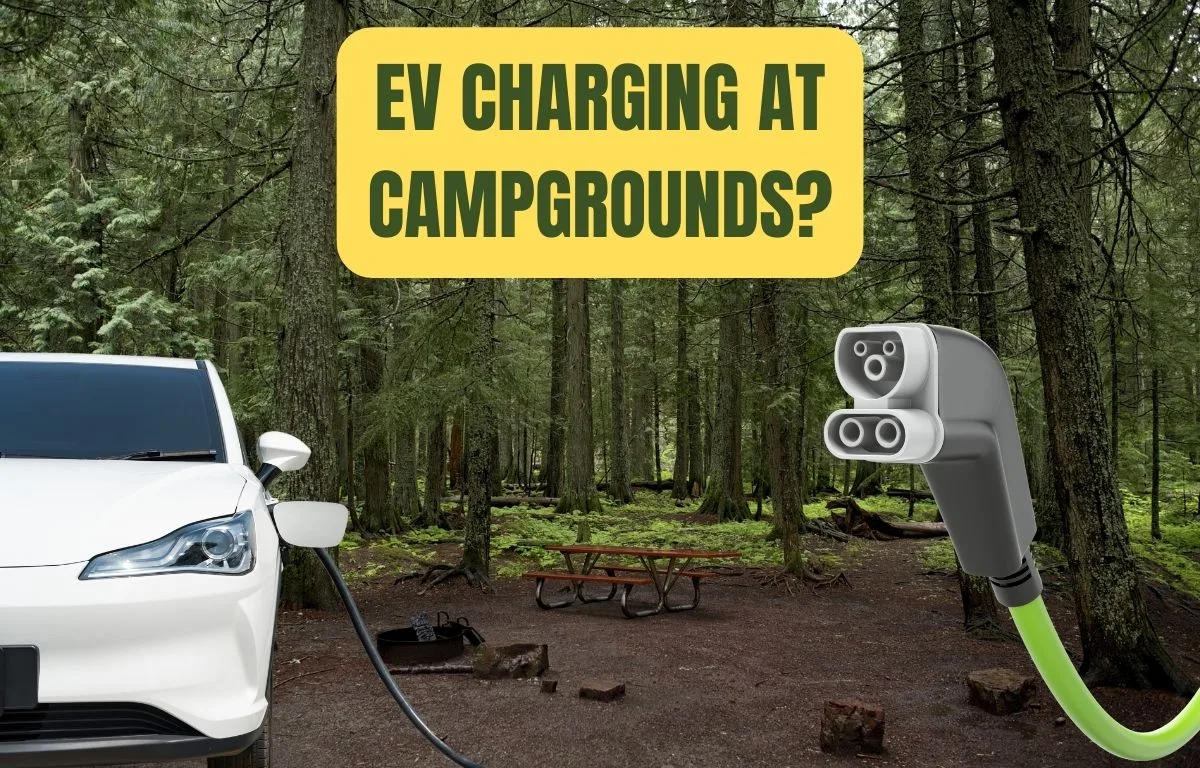
Charging an electric vehicle (EV) at a campground is possible, but it depends on the specific campground’s policies and infrastructure. Some campgrounds have strict rules against EV charging, primarily due to concerns about their electrical infrastructure. Campgrounds are designed with a specific electrical capacity to ensure consistent power distribution to all guests. The electrical systems, often established decades ago, may not support the additional load of EV charging without risking power disruptions. Therefore, it’s essential to contact the campground directly or check their website for specific guidelines on EV charging.
While the EV industry seems like it’s exploding, it’s just in its infancy. It’s just recently been possible to purchase an electric truck. And it was only last year when we’ve seen several electric SUVs enter the market. As new EV models emerge and options expand for an electric tow vehicle, the demand for EV charging at campgrounds will only increase. Camping will remain one of America’s favorite activities but will need a viable option to keep things charged. Below, we’ll dive deeper into this topic and give you all the information needed for charging your EV when camping.
Can You Charge an Electric Vehicle at an EV hookup site?
Unfortunately, the short answer to this question is “It depends.” Some RV parks have strict policies about charging electric cars, while others are less clear. The only way to get an exact answer is to contact the RV park or campground if they don’t have guidance on their website.
Also, it’s important to understand why some RV parks prohibit EV charging at the RV hookup sites. It’s not that they’re being unreasonable, but more to do with the electric infrastructure at the park. There could also be safety concerns, higher costs for the campground owners, and incompatibility with RV demands.
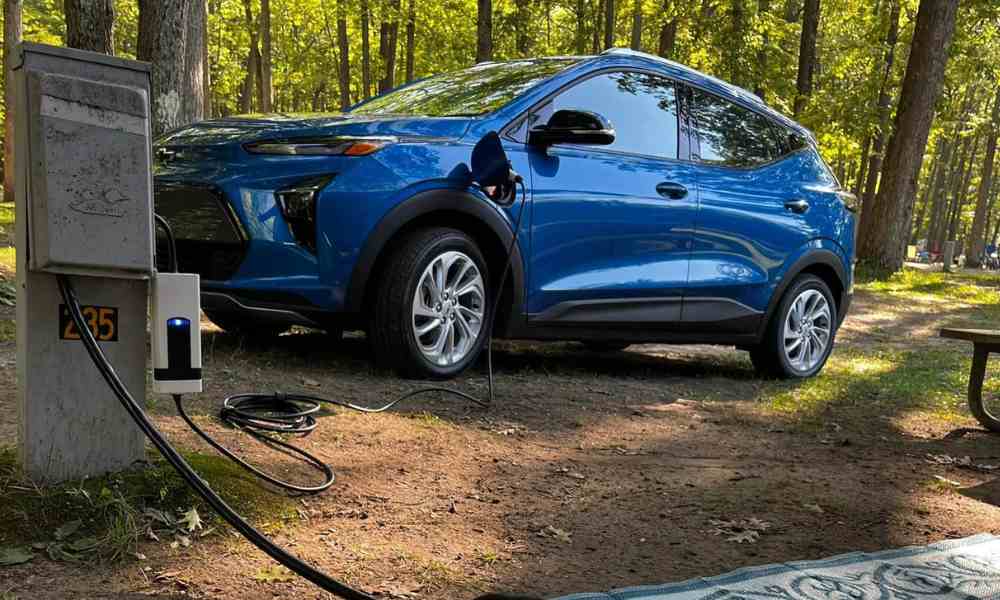
Campground Power and Infrastructure
RV parks are designed with specific electrical capacities to ensure consistent and reliable power distribution to all guests. This means that the electric grid at the campground was laid out in a way to optimize its use throughout the park. While newer RV parks may have more advanced infrastructure, many existing parks are still operating off connections installed decades ago. Charging a car places an unexpected load on the electrical system, risking power disruptions and overloads that can affect not only EV-charging guests but also others reliant on a steady electricity supply for their RVs.
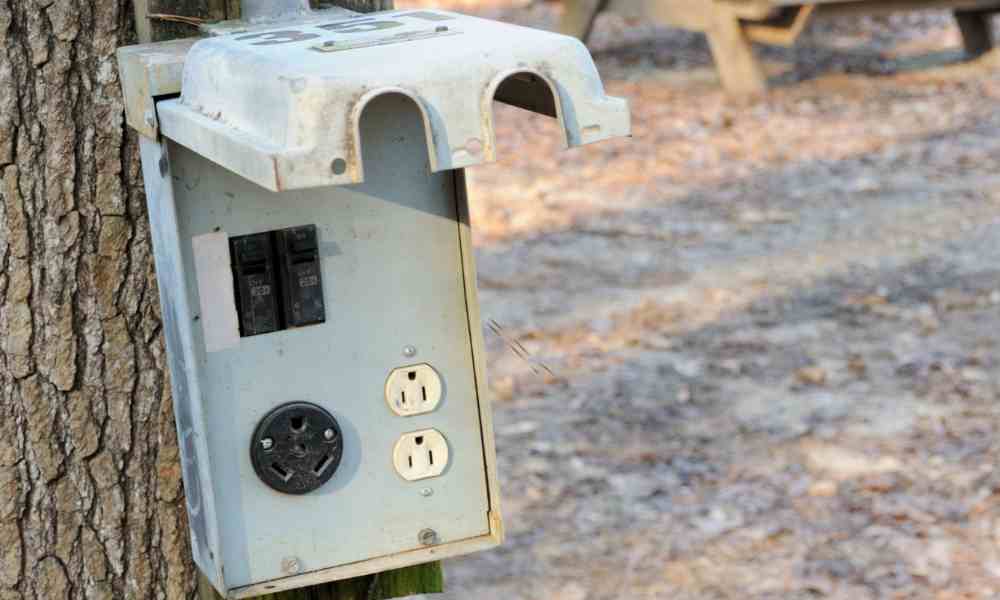
Upgrading the existing electrical infrastructure to accommodate EVs requires a substantial investment, often challenging the park’s ability to maintain its current level of service without disruptions. Electric vehicles have a different electric use profile than RVs. When charging, they require more steady power rather than variable power in RVs.
Costs for Campgrounds
Charging EVs consumes more electricity, increasing operational costs for RV parks and campgrounds. Some parks that allow charging may pass these costs along to EV users, regardless of whether or not they have an RV hooked up to the shore power. RV parks are also designed primarily to cater to the specific needs of RVs. If an RV is hooked up in addition to an electric vehicle, it may cost the campground an additional $10-$15 in electricity.
Let’s take a look at a Tesla as an example:
A Tesla Model X may have an 82 kWh battery bank. If you were to charge it from 0% to 100%, you would need 82 kWh of electricity. Assuming the electricity rate from the local provider is $0.15 per kilowatt-hour, the campground would have an additional cost of $12.30. When RV campgrounds calculate rates and expenses, they set camping fees for the anticipated costs, including electricity. Charging an EV could turn the campsite from profitable to losing money.
Cost at $0.15/kWh = 82 kWh * $0.15/kWh = $12.30
Safety and Expertise:
EV charging may create some safety risks due to the high-voltage equipment involved. While EV charging converts are relatively safe and reliable, improper usage could cause problems. Not all RV park connections are configured for the loads of EV vehicles, and overloading the pedestals or improper connections can cause problems. Some RV parks do not want to take this risk and decide to prohibit EV charging at campsites. Remember, RV parks want to find a balance between providing a comfortable experience for all guests while upholding the operational integrity, safety, and accessibility of their facilities.
Why RV electrical use is different from EV charging
RV electrical use and electric vehicle (EV) charging differ significantly in terms of their power demand profiles. The biggest difference lies in the variable electrical demand of RVs versus the relatively constant demand associated with EV charging:
RV Electrical Use:
- Variable Demand: RVs have diverse electrical demands based on factors like appliances, heating/cooling systems, lighting, entertainment devices, and more. This demand is not constant but fluctuates throughout the day and night as different appliances and systems are used.
- Power Spikes: Certain appliances like air conditioners, microwaves, or heaters can cause short-term power spikes when they turn on, leading to temporary increases in power consumption, but use less when running.
- Load Management: RV owners often need to manage their electricity usage to avoid overloading the RV’s electrical system or tripping circuit breakers. This involves prioritizing which appliances can be used simultaneously to stay within the available power capacity.
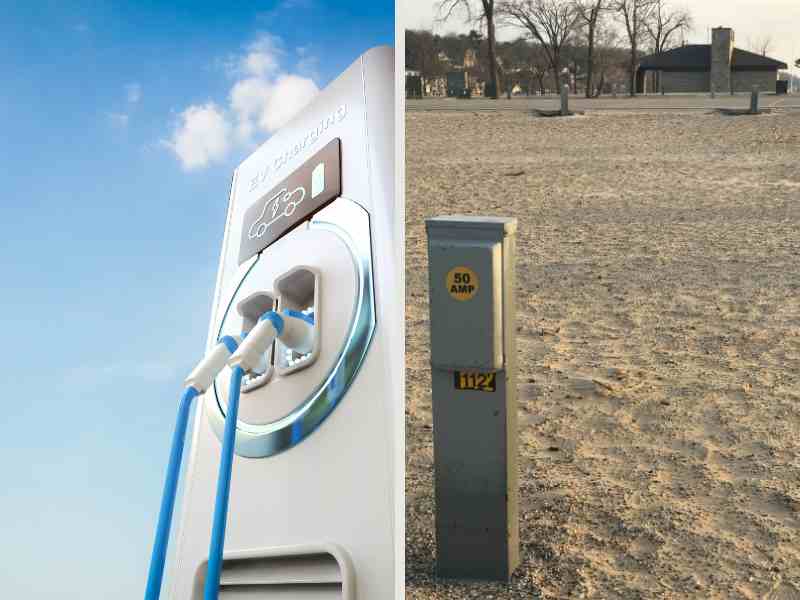
EV Charging:
- Constant Demand: EV charging typically involves a more consistent and sustained electricity demand than the variable demands of RVs. EVs require a certain amount of power over an extended period to charge their batteries.
- Longer Duration: EV charging sessions can last several hours, especially when using standard household electrical outlets (Level 1 charging), or faster with dedicated EV stations (Level 2 or Level 3 charging).
- Predictable Load: Unlike the unpredictable spikes in demand caused by various appliances in an RV, a car charges differently and follows a more predictable pattern, drawing a relatively steady amount of power throughout the charging process.
The difference in power demand profiles between RV electrical use and EV charging is important in how RV parks and facilities manage their electrical infrastructure. RV parks are designed to handle the variable and sometimes unpredictable demands of RVs. However, the relatively constant and predictable demand for EV charging, when combined with the existing RV use patterns, can pose challenges if the existing infrastructure is not equipped to accommodate the additional load. This is one of the reasons why some RV parks are cautious about allowing EV charging at their electric hookups, as the influx of EVs could strain the electrical system and potentially lead to power disruptions.
Do Campgrounds have dedicated EV Charging Stations?
Many campgrounds are recognizing the growing demand for electric vehicle (EV) charging and are beginning to install dedicated EV charging stations. While a campground may not allow charging at a campsite, they may have a dedicated EV charger located somewhere in the campground. These charging stations are specifically designed to provide a reliable and efficient way for electric vehicle owners to charge their vehicles while staying at the campground. The availability of dedicated EV charging stations is growing, and as the market creates more demand, I think we’ll see this become standard practice at campgrounds. As a bonus, it may be a great option to market their facilities to EV campers.
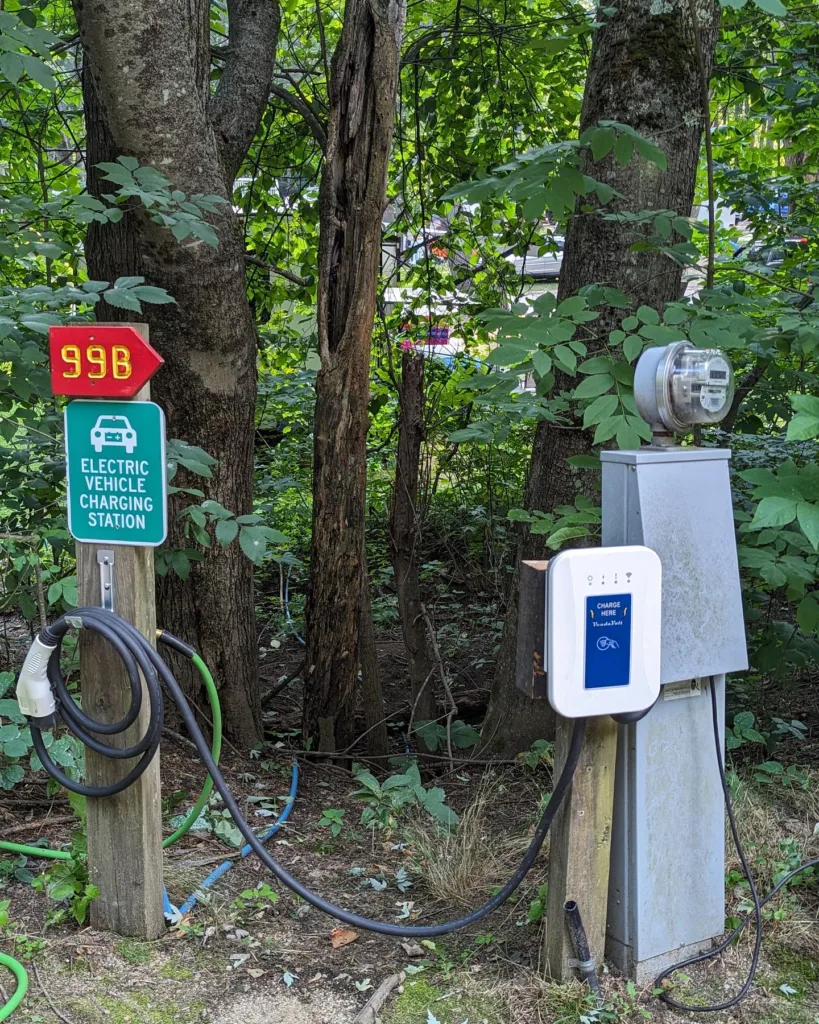
Dedicated EV charging stations at campgrounds offer several benefits:
- Convenience: EV drivers can conveniently charge their vehicles while enjoying their stay at the campground. This eliminates the need for them to search for public charging stations outside the campground.
- Attracting EV Owners: Campgrounds with EV charging stations can attract a new demographic of travelers who prefer electric vehicles. This can lead to increased bookings and revenue.
- Extended Stays: Electric vehicle charging can take several hours, incentivizing guests to extend their stay at the campground while their vehicle charges.
- Eco-Friendly Image: Campgrounds that offer EV charging stations showcase their commitment to sustainability and environmental responsibility.
- Competitive Edge: Having EV charging stations can give a campground a competitive edge over those that don’t offer this amenity.
- Partnerships: Some campgrounds may partner with EV charging network providers to offer a broader network of fast charging options by installing dedicated EV charging stations at campgrounds. This trend aligns with the broader push for sustainable travel options and the need for convenient charging infrastructure for electric vehicles.
How to Find out If a Campground has charging stations or allows EV charging?
To find out if campgrounds have electric vehicle (EV) charging stations or allow charging at the hookup, the best option is to call them. You may also find this information online:
- Check Campground Websites: Visit the official websites of the campgrounds you’re interested in. Many campgrounds list their amenities and services, including whether they offer EV charging stations or allow EV charging at the hookup. Look for dedicated sections related to amenities, services, or RV facilities.
- Contact Campground Management: Use the contact information provided on the campground’s website to contact their management or customer service. You can call or email them about EV charging options and policies. They can provide accurate and up-to-date information on whether they have charging stations or allow EV charging at the hookup.
- Use RV Park Directories and Apps: Several online directories and mobile apps are specifically designed for RV travelers. These platforms often include information about campgrounds, amenities, and available EV charging. Examples include Campendium, AllStays, RV Parky, and RVillage.
- Read Online Reviews: Search for online reviews or forums where fellow RV travelers discuss their experiences at various campgrounds. RVers often share valuable information about amenities, including whether EV charging is available or allowed.
- Social Media Pages: Many campgrounds operate social media pages or groups. You can often leave a comment or send a direct message for a quick response.
- Check EV Charging Networks: Some EV charging network providers, like ChargePoint and Electrify America, list their charging station locations on their websites or apps. You can use these platforms to search for charging stations near your desired campground (or nearby locations if none are available)
Also, one of the more likely places you’ll find traditional charging stations is at many government-run facilities—local, county, and state parks. Over the past several years, many government agencies have led the charge in installing EV charging stations at their facilities. As a result, even if the campground doesn’t have electrical hookups, the park may have them available. The National Park Service has been busy adding this infrastructure to most national parks throughout the United States.
Additionally, some nationwide campground chains are seeing the need and responding appropriately. A good example is KOA (Kampgrounds of America), which has installed EV charging stations at many of its locations. While they don’t allow charging at the pedestal, they are trying to make it convenient for EV drivers to charge up without leaving the park. KOA’s goal is to eventually have this option at all of their sites.
What types of Adapters are needed to charge at an RV site?
To charge an electric car at a 30 or 50-amp RV site, you might need certain adapters or portable EV chargers depending on the charging equipment available at the site and the type of electric vehicle you own. Here are the common options:
- Standard Level 2 Charging Station (J1772 Connector): Many RV sites with a 30 or 50-amp outlet might have Level 2 charging stations with J1772 connectors. If your electric car uses the same J1772 connector for charging, you won’t need any adapters; plug in your car.
- Tesla Electric Car (Tesla Connector): If you have a Tesla electric car, you’ll need a Tesla-to-J1772 adapter. This adapter lets you connect your Tesla to a standard Level 2 charging station with a J1772 connector.
- NEMA 14-50 Outlet: Some RV spots provide a NEMA 14-50 outlet, which is a standard 240-volt outlet for RVs. If your electric car charging equipment supports this type of outlet, you may only need the appropriate charging cable.
- RV Sites with Tesla High-Power Wall Connector (HPWC): Some RV sites offer Tesla High-Power Wall Connectors as part of their amenities. Tesla owners won’t need an adapter in this case; bring your Tesla mobile connector along and plug it into the Tesla chargers.
- Adapters for Non-Tesla Electric Cars: If your non-Tesla electric car doesn’t use the J1772 connector or doesn’t support NEMA 14-50 outlets, you might need a specific adapter to connect your car to the charging equipment available at the RV site. Some third-party adapters are available to help convert one type of connector to another.
- Bring a Variety of Adapters: It’s a good idea to carry a selection of adapters or cables that cover common charging scenarios and power options. This ensures you’re prepared for different types of charging equipment you might encounter at RV sites.
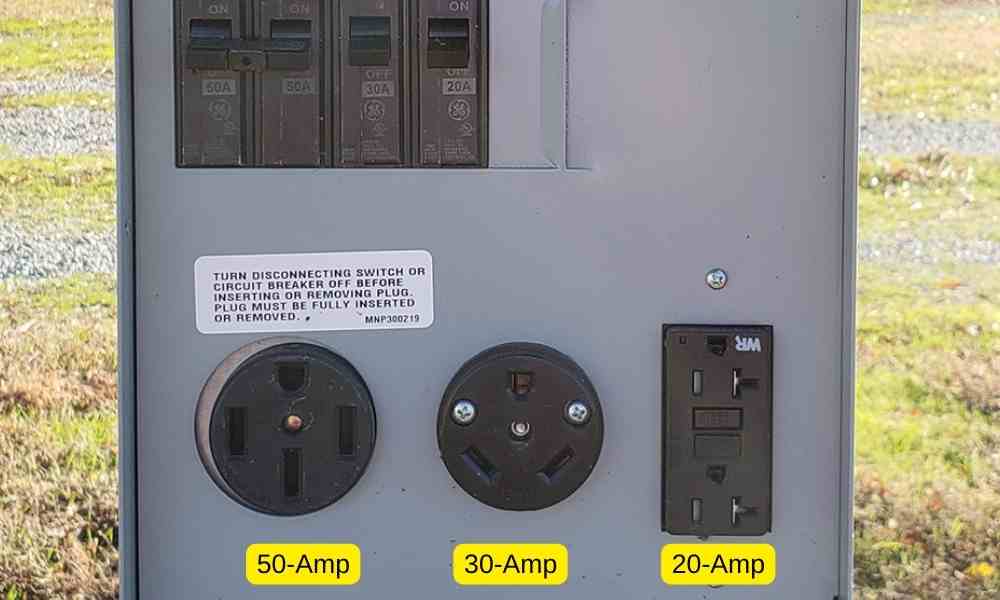
Before traveling, it’s recommended to research the specific charging equipment available at the RV sites you plan to visit and verify compatibility with your electric car’s charging requirements. This information will help you determine which adapters or cables you might need to bring along to ensure a smooth charging experience during your RV journey.
Car Camping and EV Charging Tips
I have written several articles on electric cars and why they make great camping vehicles. Whether for long road trips, sleeping in your car, or using as your regular vehicle for car camping, EVs offer many conveniences over traditional ICE (Internal Combustion Engine) vehicles. They not only get you to your destination but utilize the electric power to create innovative ways to enhance your camping experience.
However, EV ownership comes with some challenges, which include ensuring your car stays charged. The good news for cars compared to RVs is that you can easily drive the car to a charger without breaking down camp. So, even if the RV campground doesn’t have a specific EV charger or allow charging at the campsite, in many instances, you can take a short drive to the many EV charging points across North America. Fast chargers will often charge your battery in about half an hour and won’t be too much of an inconvenience.
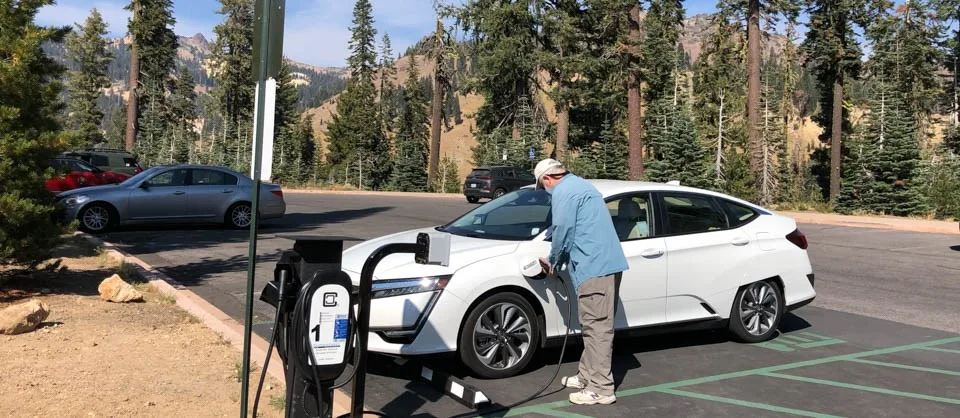
Electric cars are also very efficient when it comes to camping. Depending on your vehicle, you can customize your electrical use at the campsite when using built-in camping features like Camp Mode from Rivian and Tesla or Utility Mode from Hyundai and Kia. Climate controls will use the most power, but on a full charge, simply using the vehicle to power your lights, charge devices, or plug in 120-v appliances won’t drain your battery too much. You just need to keep an eye on your battery status to ensure you leave enough of a charge to drive to a charging station when needed. Tent camping with an EV will use even less electricity since you won’t run the heat or AC.
If camping in remote locations without nearby charging, you will need to be a little more conscious of your electrical use, ensuring you have enough miles of range to get you home (or to a charging station). While it will be slow, some EV campers carry a portable power station and solar panels. In a pinch, you may be able to get enough charge during the day to make it a few extra miles to a charging station or electrical outlet.
How will campgrounds manage electric RV charging in the future?
The future of all-electric RVs holds promise for environmentally conscious travelers seeking sustainable and efficient alternatives. As electric vehicle (EV) technology advances, all-electric RVs will become an option. To ensure their successful integration into campground environments, these vehicles may need to be built with carefully designed charging profiles that avoid straining campground electrical infrastructure.
All-electric RVs offer several benefits, including reduced emissions, quieter operation, and potentially lower operational costs than traditional fossil fuel-powered RVs. However, one of the challenges lies in managing the power demand from a significant number of EVs charging simultaneously within campgrounds. To address this issue, the design of all-electric RVs could incorporate the following strategies:
- Smart Charging Technology: All-electric RVs could feature advanced charging systems that communicate with campground infrastructure. This technology would enable RVs to coordinate their charging profiles to avoid peak demand periods, spreading the power load evenly throughout the day.
- Adaptive Charging Speeds: RVs could be equipped with adaptive charging capabilities that adjust the charging speed based on the campground’s available electrical capacity. This would prevent sudden surges in demand and help maintain a stable power supply for all guests.
- Scheduled Charging: RV owners might have the option to schedule their charging sessions during off-peak hours, reducing the strain on the campground’s electrical infrastructure during busy times. This would ensure a more efficient use of available power resources.
- Load Management: All-electric RVs could incorporate load management systems prioritizing essential vehicle functions while charging. This way, power is allocated intelligently, ensuring critical onboard systems operate smoothly even during charging sessions.
- Energy Storage Integration: Some all-electric RVs might include energy storage systems, such as batteries or supercapacitors, which can temporarily store excess energy during off-peak hours. This stored energy could then be used for charging during peak times, alleviating pressure on the campground’s electrical grid.
- Campground Collaboration: RV manufacturers and campground operators could collaborate to develop standardized charging protocols that optimize power usage within campgrounds. This could involve sharing data and insights to create a seamless charging experience for all-electric RV owners.
- Power Sharing and Grid Support: Advanced all-electric RVs might have the ability to provide power back to the campground’s grid during periods of high demand. This bidirectional energy flow could help stabilize the grid and improve the overall resilience of the electrical system.

In the future, as the adoption of all-electric RVs increases, RV manufacturers and campground operators will likely need to work together to create an ecosystem that supports sustainable and responsible charging practices. By incorporating innovative charging profiles and technologies, all-electric RVs can coexist harmoniously with campground electrical infrastructure, ensuring a positive experience for RV owners and guests while contributing to a greener and more efficient travel landscape. It’s very likely we’ll see charging stations listed alongside amenities like picnic tables and fire rings.
Summary
With electric vehicles becoming a popular option for getting to the great outdoors and camping when you’re there, figuring out your charging options is an important step when planning your trip. If you’re staying at a traditional campground, a good option is to call them and ask about charging policies at the campsite or if they have dedicated EV charging stations. If they don’t, they may know the location of the nearest chargers.
Many campgrounds will prohibit charging at the camp site. It’s not that they’re being picky, but their infrastructure may not be able to handle it. Also, they may be concerned about costs, which can increase with EV charging. However, more and more campgrounds are beginning to install dedicated EV chargers to accommodate the growing demand for this service. In general, this is a move we’re seeing many businesses in the outdoor industry make.
Camping in an EV can be fun and convenient. Whether you’re heading down to your local campground or road tripping across the country, it’s becoming easier to charge up with every passing day. It just takes a little research to ensure you have charging options where you need them.
